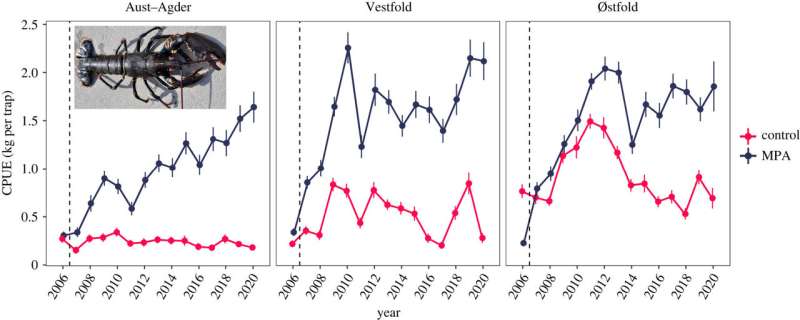Overfished lobster found to grow bigger in protected areas

A team of researchers at the University of Agder’s, Center for Coastal Research, working with a colleague at the Institute of Marine Research, both in Norway, has found that when protected areas for lobsters are established in overfished parts of the sea, the lobsters tend to grow bigger. In their paper published in Proceedings of the Royal Society B, the group describes their study of lobsters inside and outside of protected zones off the coast of Norway.
Prior research has shown that both hunting and fishing tend to be size-selective, which in turn tends to favor slow body growth. And that has led to reductions in body size and shorter lifespans. Prior research has also shown that overfishing can lead to reductions in populations of fished species, leading to smaller yields. Because of that, wildlife management officials around the world have created sanctuaries where hunting and/or fishing are not allowed, and that has allowed populations to rebound.
In this new effort, the researchers wondered about changes to body size in European lobsters living off the coast of Norway. To grow larger, the lobster must molt, shedding its hard shell, which makes it vulnerable to predators. Prior research has shown that in overfished areas, lobsters sometimes skip the molting process as a defense mechanism, and that leads to decreasing body size in populations as a whole. To find out if this process is reversed in marine protected areas, the researchers caught a number of specimens inside and outside the protected zones, measured them and then compared sizes between areas.
The researchers found that lobsters in the protected zones resumed molting and began to grow larger. They also found that the population numbers as a whole also grew—catch rates in the protected areas were 142% higher than in non-protected zones.
The researchers suggest that not only do protected areas allow lobsters to resume normal growth rates, but spillover between protected and non-protected zones also see some degree of increase.
More information:
Tonje Knutsen Sørdalen et al, Protection from fishing improves body growth of an exploited species, Proceedings of the Royal Society B: Biological Sciences (2022). DOI: 10.1098/rspb.2022.1718
© 2022 Science X Network
Citation:
Overfished lobster found to grow bigger in protected areas (2022, November 24)
retrieved 24 November 2022
from https://phys.org/news/2022-11-overfished-lobster-bigger-areas.html
This document is subject to copyright. Apart from any fair dealing for the purpose of private study or research, no
part may be reproduced without the written permission. The content is provided for information purposes only.
For all the latest Science News Click Here
For the latest news and updates, follow us on Google News.

